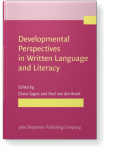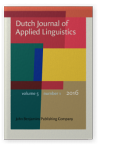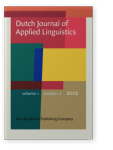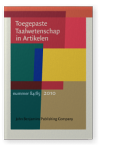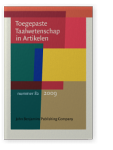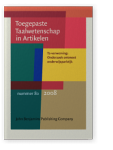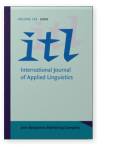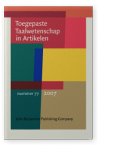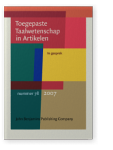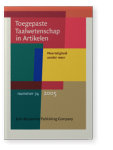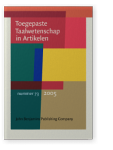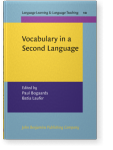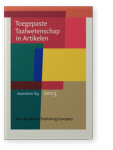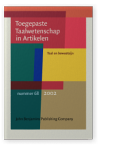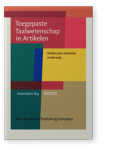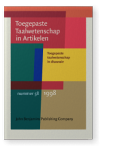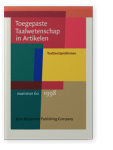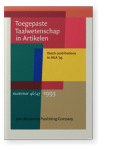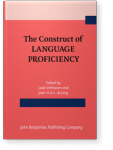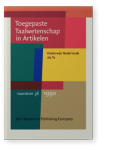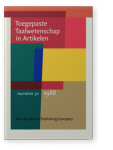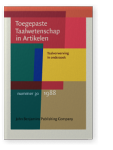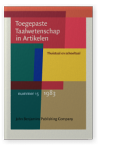Anne Vermeer
List of John Benjamins publications for which Anne Vermeer plays a role.
2017 Development of qualifiers in children’s written stories Developmental Perspectives in Written Language and Literacy: In honor of Ludo Verhoeven, Segers, Eliane and Paul van den Broek (eds.), pp. 237–255 | Chapter
In general, stories written by children in which many details are used are perceived as being more attractive. However, the use of stylistic elements in children’s writings has scarcely been described. We investigated stories written by 320 elementary school children from grades 3 to 6, focusing on… read more
2016 Lexicale rijkdom, frequentielagen en tekstmoeilijkheid Dutch Journal of Applied Linguistics 5:1, pp. 18–33 | Article
In line with recent developments in both language acquisition and text comprehension studies, it is argued that more reliable and valid lexical richness measures can be obtained by including frequency class information. To that end, texts written by 452 elementary school children (L1/L2) in grades… read more
2012 Evaluatieve tweets van studenten en het effect van een interventie door docent-volgers Dutch Journal of Applied Linguistics 1:2, pp. 236–251 | Article
In this study, 21,085 tweets from university students over a period of twelve weeks were analyzed. Our aim was to investigate the number and evaluative content of students’ tweets related to their study, and to know whether the number of negative tweets decreases when teachers follow students on… read more
2010 Verwervingsvolgorde van Relationele Coherentie Bij NT1- en NT2-Kinderen van 4 tot 8 Jaar Toegepaste Taalwetenschap in Artikelen 84/85, pp. 59–69 | Article
This article focuses on the emergence of relational coherence in linguistic expressions such as and, but, then, while, until, before. When do children start expressing relational coherence through various additive, temporal and causal connectives? Within a cognitive theory of coherence relations… read more
2009 Wat Is Een Optimale Tekstdekking? Woordkennis En Tekstbegrip In Groep Toegepaste Taalwetenschap in Artikelen 82, pp. 81–92 | Article
How much of the vocabulary in a text needs to be known ('text coverage') to arrive at a proper comprehension of the text? On the basis of a vocabulary test, 175 pupils of grade 4 were divided into four groups with different vocabulary sizes. Next, in three sessions they read six texts differing in… read more
2008 Online Kranten, Een Model Van De (Tweede-)Taalleerder En Het Genereren Van Adaptief Lesmateriaal T2-verwerving: Onderzoek ontmoet onderwijsparktijk, pp. 49–61 | Article
This article explores the question whether or not a user model with an automated adaptive selection of online generated and enriched reading texts from newspapers ensures that readers of different vocabulary levels receive linguistic input that is best suited to their abilities and preferences. In… read more
2008 Automated User-Centred Task Selection and Input Modification in Language Learning ITL - International Journal of Applied Linguistics 155, pp. 1–21 | Article
This article presents the results of a CALL-experiment in which reading material is selected dynamically, based on the “fit” between the vocabulary proficiency of individual students and the relative difficulty of texts. The texts were analysed, selected and presented online, together with a… read more
2007 Leerkrachtvaardigheden En Woordenschatonderwijs: Het effect van training op leerkrachtgedrag en leerlingprestaties Toegepaste Taalwetenschap in Artikelen 77, pp. 9–19 | Article
The research in this article deals with the effect of a teacher training course on vocabulary teaching and learning. Two months before, and three months after an intensive vocabulary teaching training course, four teachers of different grades in primary education were observed and interviewed, and… read more
2007 E-learning op Maat: Automatische geïndividualiseerde materiaalselectie in het tweede-taalonderwijs In gesprek, pp. 119–130 | Article
The present study explored the effect of reading texts in an electronic learning environment for 46 adult second language learners of Dutch with different proficiency levels. The reading materials were selected dynamically, based on the "fit" between the vocabulary proficiency of individual… read more
2005 Brede en Diepe Woordkennis, Vaktaal en Tekstbegrip Meertaligheid zonder meer, pp. 45–58 | Article
In this article various aspects of word knowledge and their relations to the text comprehension skills have been investigated for 197 monolingual and bilingual children in grade 5. All children performed three different vocabulary tasks, measuring breadth (quantitative knowledge: 'how many words do… read more
2005 Het Ongelijk van Netelenbos? Toetsing van Kleuters en hun Prestaties op de Cito Eindtoets Basisonderwijs Meertaligheid zonder meer, pp. 123–133 | Article
Within the context of school success of ethnic minority children in the Netherlands, it is currently debated what criteria should be applied by the Ministery of Education in assigning extra funds to children at risk. To this date, two criteria are used: level of parental education and parents'… read more
2005 Hiërarchische Relaties en Woordenschatonderwijs Toegepaste Taalwetenschap in Artikelen 73, pp. 99–110 | Article
It is generally acknowledged, that in vocabulary learning and teaching, the main important factors are frequency, meaningful context, and variation in input. Within the last factor, some researchers stress the importance of hierarchical relations between words (paradigmatic relations as in animal… read more
2004 9. The Relation between lexical richness and vocabulary size in Dutch L1 and L2 children Vocabulary in a Second Language: Selection, acquisition, and testing, Bogaards, Paul and Batia Laufer (eds.), pp. 173–189 | Chapter
2003 Een Passende Woordkeus: Het kiezen van Woorden voor Woordenschatlessen Toegepaste Taalwetenschap in Artikelen 69, pp. 9–22 | Article
This article deals with the selection of words for curriculum materials, in the light of the choice made in a cdrom on vocabulary learning and a language learning method in primary education. First, some criteria for vocabulary selection are discussed. Next, it is shown that the selection of words… read more
2002 Leerkrachten Vinden Meisjes Taalvaardiger: (Voor)oordelen over de taalvaardigheid Nederlands van autochtone en allochtone jongens en meisjes in het Speciaal Basisonderwijs Taal en bewustzijn, pp. 85–94 | Article
In this paper, we investigated, for 90 Dutch L1 and L2 children in Special Education, whether differences in Dutch language proficiency could be found between boys and girls, and whether the outcomes are in line with the evaluations of the teachers about the proficiency of these boys and girls.… read more
2000 Lexicale Rijkdom, Tekstmoeilijkheid en Woordenschatgrootte Onderzoek ontmoet onderwijs, pp. 95–105 | Article
Most measures of lexical richness in spontaneous speech data, based on the distribution of, or the relation between the types and tokens, appear to be neither reliable nor valid. The article describes a semi-automatic computer program, MLR (Measure of Lexical Richness) that measures lexical… read more
1998 Toegepast? Reactie op 'Modellen en metingen van taalvaardigheid' Toegepaste taalwetenschap in discussie, pp. 181–183 | Article
1998 Tekstdekking in Groep 5: Woordkennis als Oorzaak van het Mattheüs-effect in het Basisonderwijs Taal(leer)problemen, pp. 9–18 | Article
Research on primary school children shows that the differences between L1-Dutch children on the one hand, and L2-Dutch children on the other, tend to become greater, which is a process in which the children's proficiency in Dutch plays a major role. In this paper it is shown that word knowledge is… read more
1992 13. Modeling communicative second language competence The Construct of Language Proficiency: Applications of psychological models to language assessment, Verhoeven, Ludo and John H.A.L. de Jong (eds.), pp. 163–174 | Article
1992 12. Exploring the second language learner lexicon The Construct of Language Proficiency: Applications of psychological models to language assessment, Verhoeven, Ludo and John H.A.L. de Jong (eds.), pp. 147–162 | Article
1990 Uitbreiding Woordenschat nt2 in de Kleuterklassen Onderwijs Nederlands als T2: De stand van zaken, pp. 36–47 | Article
1988 Spontane Taaldata En Het Meten Van Lexicale Rijkdom In Tweedetaalverwerving Toegepaste Taalwetenschap in Artikelen 32, pp. 108–122 | Article
Increasing use of spontaneous speech data in second language research made it necessary to use other measures than tests for getting insight into the lexical richness of (spoken) text corpora of second language learners. In this article several lexical measures (types, TTR, TTR(c), Guiraud,… read more
1988 Spontane Taaldata en het Meten van Lexicale RIJKDOM I Tweede-taalverwerving Taalverwerving in onderzoek, pp. 67–80 | Article
Increasing use of spontaneous speech data in second language re-search made it necessary to use other measures than tests for getting insight into the lexical richness of (spoken) text corpora of second language learners. In this article several lexical measures (types, TTR(c), Guiraud, logTTR,… read more
1983 Tweede-Taalverwerving Door Turkse en Marokkaanse Kinderen Thuistaal en schooltaal, pp. 64–78 | Article
In second language acquisition two aspects may be distinguished, namely structure (or order and speed or success) of second language acquisition. The structure of second language acquisition is mainly determined by cognitive strategies and has a strong universal character. Speed, however, is for… read more
